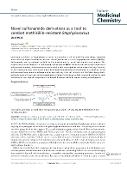Novel sulfonamide derivatives as a tool to combat methicillin-resistant Staphylococcus aureus

Datum vydání
2024Publikováno v
Future Medicinal ChemistryRočník / Číslo vydání
16 (6)ISBN / ISSN
ISSN: 1756-8919ISBN / ISSN
eISSN: 1756-8927Metadata
Zobrazit celý záznamTato publikace má vydavatelskou verzi s DOI 10.4155/fmc-2023-0116
Abstrakt
Increasing resistance in Staphylococcus aureus has created a critical need for new drugs, especially those effective against methicillin-resistant strains (methicillin-resistant Staphylococcus aureus [MRSA]). Sulfonamides are a privileged scaffold for the development of novel antistaphylococcal agents. This review covers recent advances in sulfonamides active against MRSA. Based on the substitution patterns of sulfonamide moieties, its derivatives can be tuned for desired properties and biological activity. Contrary to the traditional view, not only N-monosubstituted 4-aminobenzenesulfonamides are effective. Novel sulfonamides have various mechanisms of action, not only 'classical' inhibition of the folate biosynthetic pathway. Some of them can overcome resistance to classical sulfa drugs and cotrimoxazole, are bactericidal and active in vivo. Hybrid compounds with distinct bioactive scaffolds are particularly advantageous.
Klíčová slova
antibacterial activity, drug resistance, mechanism of action, methicillin-resistant Staphylococcus aureus, molecular hybridization, Schiff bases, Staphylococcus aureus, sulfonamides
Trvalý odkaz
https://hdl.handle.net/20.500.14178/2250Licence
Licence pro užití plného textu výsledku: Creative Commons Uveďte původ 4.0 International







